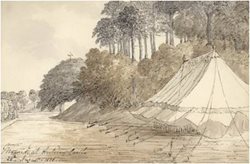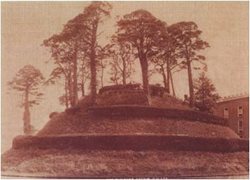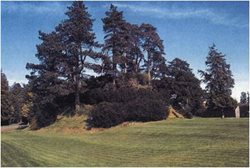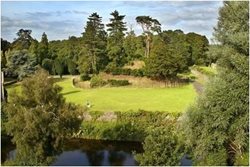Learn the history of the Ancient Motte
The splendidly preserved Motte close to the eastern boundary of the gardens was built in the late 12th century by John de Courcy, Earl of Ulster or one of his followers. It is among one of the finest in Ireland. By 1210 the Castle of Antrim had passed to the Crown and is well documented in the accounts of King John between 1211 and 1212 when it was garrisoned by 2 knights, 12 armed archers and up to 40 foot soldiers.
The Motte castle was the centre of an Anglo-Norman manor and other records refer to a nearby bridge, the building of byres and barns, numerous plough teams and other items of a busy settlement. The timber castle would have stood on the top of the mound, which is approximately 9 metres high. Considering its royal status, it is highly probable that it had a bailey (a fortified enclosure for a garrison) the remains of which may lie beneath the nearby Terrace gardens.
On arrival in Antrim with a grant of the estate of Massereene in 1606, Sir Hugh Clotworthy enclosed the Motte within a walled bawn of 5 acres and established a garrison complete with castle to carry out his role as Captain of Lough Neagh. The Motte provided an excellent vantage point for the Lough and surrounding area, and a large cannon was duly placed on top.
Subsequently, the Motte became an integral part of the development of the Castle Gardens providing a focal point for the avenue layout in the late 17th and early 18th century garden (note the fabulous glimpse through the Yew tunnel and along the Canal to the Cascade on climbing the Motte) and then undergoing a major landscape makeover with spiral Yew hedge and Scots Pines in the mid 19th century.

Drawing of the Motte from 1828 with tent erected on the ‘Croquet Lawn’

Photograph of the Motte from late 19th/early 20th century showing the Victorian landscaping additions of Scots Pine and spiral Yew hedge incorporated by the 10th Viscount Massereene. The photograph also demonstrates how close the Castle stood to the Motte.

After the Castle fire of 1922 and the Massereene family’s withdrawal from Antrim, the Motte went into steady decline with uncontrolled growth and serious erosion of the soil until by the 1990s it was in serious need of repair

In the 1990s a long process of consolidation in readiness for a major programme of restoration was commenced. The Motte was fenced and remedial work was carried out to stop soil erosion. By the time of this photograph in 2003, the fruits of this work are starting to show